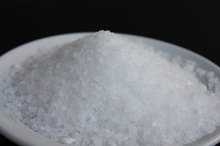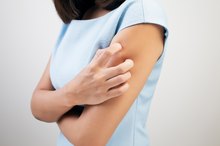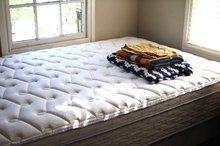What does fact checked mean?
At Healthfully, we strive to deliver objective content that is accurate and up-to-date. Our team periodically reviews articles in order to ensure content quality. The sources cited below consist of evidence from peer-reviewed journals, prominent medical organizations, academic associations, and government data.
The information contained on this site is for informational purposes only, and should not be used as a substitute for the advice of a professional health care provider. Please check with the appropriate physician regarding health questions and concerns. Although we strive to deliver accurate and up-to-date information, no guarantee to that effect is made.
How to Get Rid of Bird Mites on a Human
Bird mites, which are also known as pigeon mites and avian mites, are small, eight-legged insects that survive off the blood of warm-blooded animals such as pigeons, cats, and humans. An infestation of bird mites in humans most often begins after squabs, or baby pigeons, leave the nest and the mites must search for a new source of nutrition. If you are suffering from a bird mite infestation, most likely it came from that seemingly innocuous nest sitting outside your window. These mites made their way into your home through a window and are now biting your family and causing irritation, itching and possibly, an infection.
If you are experiencing serious medical symptoms, seek emergency treatment immediately.
Shower daily 2. Showering is more effective than lying in a bath, because the mites do not simply die in the pool of warm water. Instead, shower in hot water and use a loofah and Epsom salt to scrub the mites off your body.
How to Kill Mites on the Hair Follicles
Learn More
Cleanse the body with a mixture bleach and water. Make sure that the bleach is extremely diluted. Mix the ingredients in a spray bottle and use it in the shower, taking care not to spray the concoction in your eyes. Allow the bleach solution to remain on your skin for 30 seconds and rinse your body thoroughly.
Wash your hair with a mixture of vinegar and water. Tea tree oil is also a miticide (mite killer); you can add it to your shampoo. In severe cases women have cut their long hair to stave off the infestation, but this is a worst-case scenario. Wear a shower cap at night to keep the mites out of your hair.
How to Kill Lice on Furniture
Learn More
Towel dry your body, and use a spray deodorant that contains the active ingredient Aluminum Chlorohydrate 24 percent, such as Arrid Extra dry. This not only kills mites, but repels them as well. Use this deodorant on your clothing too.
Remove mites from clothing with a lint roller. Change the tape often and dispose of it immediately in an outdoor garbage can. Pull mites from bare skin with duct tape.
Launder your clothing and sheets in hot water. Add ½ cup of ammonia to laundry soap. Wash whites with bleach. Dry your clothing on the hottest setting. You may need to repeat these steps often until you have successfully eradicated the mites from your clothing and bedding.
Warnings
Contact your doctor immediately if you or your family members show signs of infection caused by itching mite bites. These signs include redness, swelling and heat around the affected area.
In rare cases, people have had a severe allergic, anaphylaxis, caused by a mite bite. Symptoms include wheezing, shortness of breath, hives, nasal congestion, nausea, vomiting and dizziness. Seek immediate medical attention if these signs are present.
Related Articles
References
- Birds 123
- Birdmites.org
- Medline plus
- Wilson JM, Platts-mills TAE. Home environmental interventions for house dust mite. J Allergy Clin Immunol Pract. 2018;6(1):1-7. doi:10.1016/j.jaip.2017.10.003
- Portnoy J, Miller JD, Williams PB, et al. Environmental assessment and exposure control of dust mites: a practice parameter. Ann Allergy Asthma Immunol. 2013;111(6):465-507. doi:10.1016/j.anai.2013.09.018
- Zhong NS, Ip M, Chan-Yeung M, Lam WK. Respiratory Medicine: An Asian Perspective. Hong Kong: Hong Kong University Press; 2005.
- Szefler SJ, Bonilla FA, Akdis CA, Sampson H. Pediatric Allergy: Principles and Practice. New York, NY: Elsevier Health Sciences; 2015.
- Leas BF, D'anci KE, Apter AJ, et al. Effectiveness of indoor allergen reduction in asthma management: a systematic review. J Allergy Clin Immunol. 2018;141(5):1854-1869. doi:10.1016/j.jaci.2018.02.001
- Centers for Disease Control and Prevention. Asthma. Updated May 7, 2020.
- NIH National Heart, Lung, and Blood Institute. Guidelines for the diagnosis and management of asthma. Updated September 2012.
Writer Bio
Residing in Chippewa Falls, Wis., Jaimie Zinski has been writing since 2009. Specializing in pop culture, film and television, her work appears on Star Reviews and various other websites. Zinski is pursuing a Bachelor of Arts in history at the University of Wisconsin.






